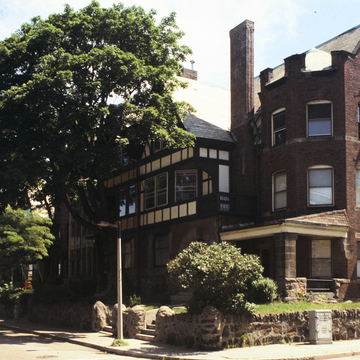Epitomizing the rapid suburbanization of Roxbury in the late nineteenth century, Harriswood Crescent forms a block of English Tudor houses opposite Harris Park. The park, characterized by a rocky terrain with mature trees, was established in 1852 and improved in 1907 and 1912, the last time by the Olmsted Brothers. Beal's designs for the row of houses along the east side of the park are unusual for Boston. Trained at MIT and in the offices of New York architects Richard Morris Hunt and McKim, Mead and White, Beal produced a design more typical of the urban areas of New York or Pennsylvania. Built as fifteen separate units, the picturesque composition appears as a row of seven houses unified by variations in Tudor Revival decorative motifs.
You are here
Harriswood Crescent
If SAH Archipedia has been useful to you, please consider supporting it.
SAH Archipedia tells the story of the United States through its buildings, landscapes, and cities. This freely available resource empowers the public with authoritative knowledge that deepens their understanding and appreciation of the built environment. But the Society of Architectural Historians, which created SAH Archipedia with University of Virginia Press, needs your support to maintain the high-caliber research, writing, photography, cartography, editing, design, and programming that make SAH Archipedia a trusted online resource available to all who value the history of place, heritage tourism, and learning.


